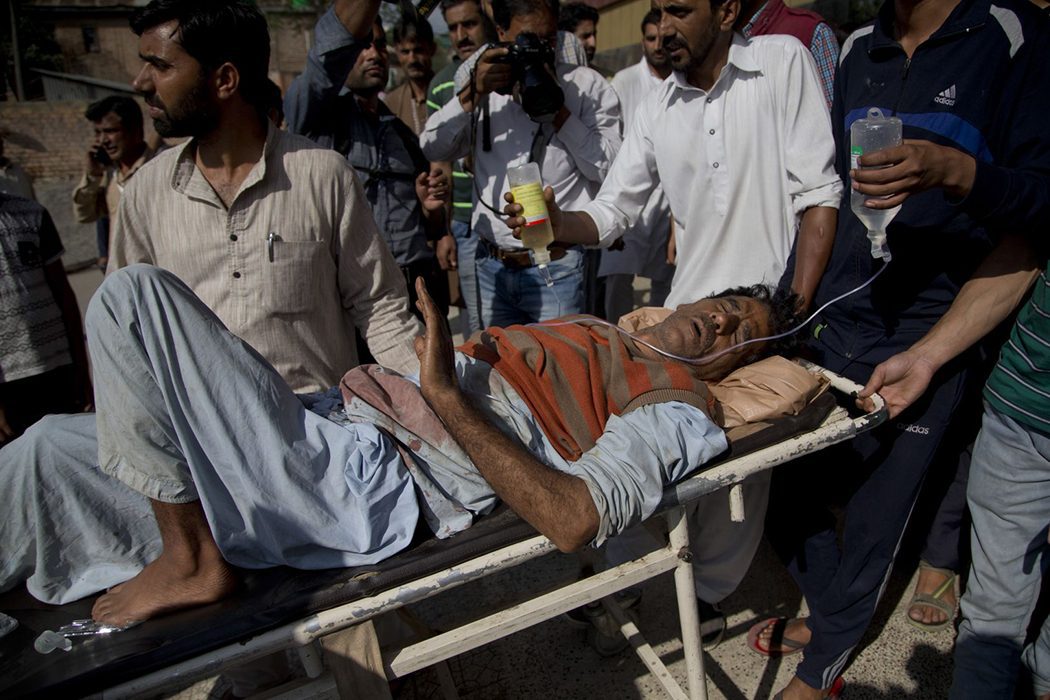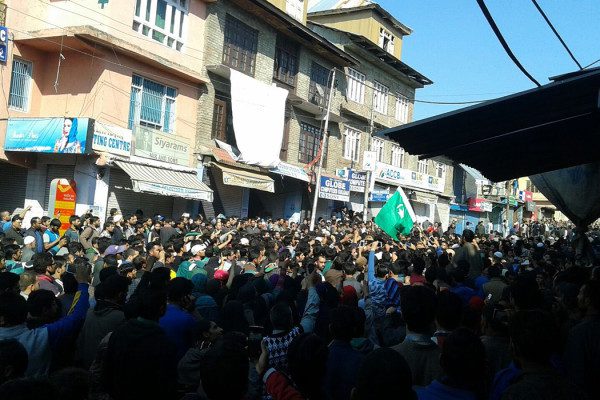The trauma for the people of Kashmir does not end with bullets and pellets. Taking the injured to hospital has been dangerous lately, reports Sana Fazili.
Emis aes ner czemich. Emis aes gooi laamich”—his arm was cut, he was shot—says a little girl to her mother sitting on the wooden bench in Srinagar’s Shri Maharja Hari Singh hospital. This little girl just saw a boy being rushed on a wheelchair. A bandage was wrapped around his head and arms. It took a while for the people there to realise that his arm had been cut from the elbow down. The amputated arm was carried by an attendant. The women started wailing at this sight and the reception area of the hospital started to reverberate with slogans. “Hum kya chahte? Azadi!”—What do we want? Freedom!
This boy has been ferried from south Kashmir. As soon as it could be ascertained where he was from and what had happened, a whistle blows outside, indicating that another ambulance has arrived. Volunteers donning jackets of their NGO rush towards the entrance. Another causality arrives, this time from north Kashmir’s Sopore area. The people there form two rows on either side from the entrance to the lift, as if making way for a groom. As soon as this patient is lowered on the stretcher and taken inside, the reception area again reverberates with “Hum kya chahte? Azadi!” This boy is accompanied by his friends, who are seething in anger. They insist on accompanying him in the lift and volunteers try to convince them that the lift can’t take all of them. The bystanders intervene and the angry boys take the stairs adjacent to the lift.
As the hospital has seen heavy inflow of the injured in police action, the regular patients there consider every bandaged person is a causality of police action. A woman looks at a five-year-old boy whose head is wrapped in bandage and asks, “Emis bachas ti cha gooi laamich?”—Has this kid been shot too?—though this kid had injured his head while playing.
A medical emergency has been declared in Valley hospitals. The claims of maximum restraint are rubbished each time a youth reaches the hospital.
From 9 July itself, more than 30 people have been killed after the Valley erupted in angry protests over Burhan Wani’s extra-judicial killing. Scores have been injured, most of the cases coming from south Kashmir’s Anantnag, Pulwama, Kulgam and Shopian districts. A medical emergency has been declared in Valley hospitals. The claims of maximum restraint are rubbished each time a youth reaches the hospital.
The trauma for the people of Kashmir does not end with bullets and pellets. Taking the injured to hospital has been dangerous lately. Police and paramilitary troops are attacking ambulances ferrying these patients, mostly from South Kashmir. One such case arrives in SMHS hospital from Anantnag district’s Bijbehara area, the hometown of chief minister Mehbooba Mufti.
The ambulance is carrying Amir Nazir, who received a bullet on the left of his abdomen. His father says he was shot at by the police without any provocation. “The situation in Bijbehaar was quiet since morning. There was no protest or stone pelting. Amir was on the bank of Jhelum River when the police fired a bullet from the other side of Jhelum,” says Nazir Ahmed, Amir’s father. His rolled up sleeves reveal the bruises of the assault by the forces. Amir was rushed to the sub-district hospital, Bijbehara, where he was referred to SMHS.
In Bijbehara town, police and paramilitary troops unleashed terror on the ambulance carrying Amir. The windows were broken, the attendants, including Amir’s father and uncle, were dragged out and beaten black and blue.
In Bijbehara town, police and paramilitary troops unleashed terror on the ambulance carrying Amir. The windows were broken, the attendants, including Amir’s father and uncle, were dragged out and beaten black and blue. “They tried to drag out my son, but we resisted,” Nazir Ahmed adds. The driver was beaten till he fell unconscious; it seemed that the troops did not want them to reach the hospital. “The driver was unconscious. Luckily, a boy turned up, who rushed the ambulance from there.” Nazir says they don’t know what happened to the driver. Before reaching Srinagar, the ambulance was stopped at three more places by the forces, but they rushed past them, fearing more batons and even bullets.
The trauma for the patients injured in police action does not end here. It follows them into the hospital premises. Hospitals in various parts of the Valley have reportedly been ransacked by security forces and threatened not to treat the patients injured in police action. Attendants are now wary of being photographed; they fear these photos might be sent to police and that they will be harassed further. When a photographer clicks a picture of an injured boy being rushed into the hospital, he is surrounded by a few angry men and asked not to do so. They have to be convinced that they are professional photographers and do not mean any malice.
Ward Number 8 of the hospital is flanked by beds on each side, and each bed has a patient. Catering to ophthalmology patients, the ward is full. Barring a few, all other cases are of pellet injuries. In the past three days of turmoil in the valley, around 80 boys have been suffered injuries in their eyes due to the pellets—a non-lethal weapon. They might lose their eyesight forever.
The fear of surveillance and subsequent harassment looms here too. A father sits by his 17-year-old son. His son’s right eye is swollen shut—a victim of a pellet gun. Clot-like bruises are all over his arms and face. Hailing from the Achabal area of Anantnag district, this man refuses to reveal his name or his son’s name. He is sceptical even about revealing his school. “Ask us what happened and how it happened. I will tell you everything. But don’t ask us things that will cause us problems,” the man says.



Neeraj Bhushan
“Police and paramilitary troops are attacking ambulances ferrying these patients, mostly from South Kashmir.” – If this sentence is true, it is an altogether a different situation. Please provide more info and may I say verify this and elucidate, if possible by witnesses. Reporter’s version seem exaggerated.